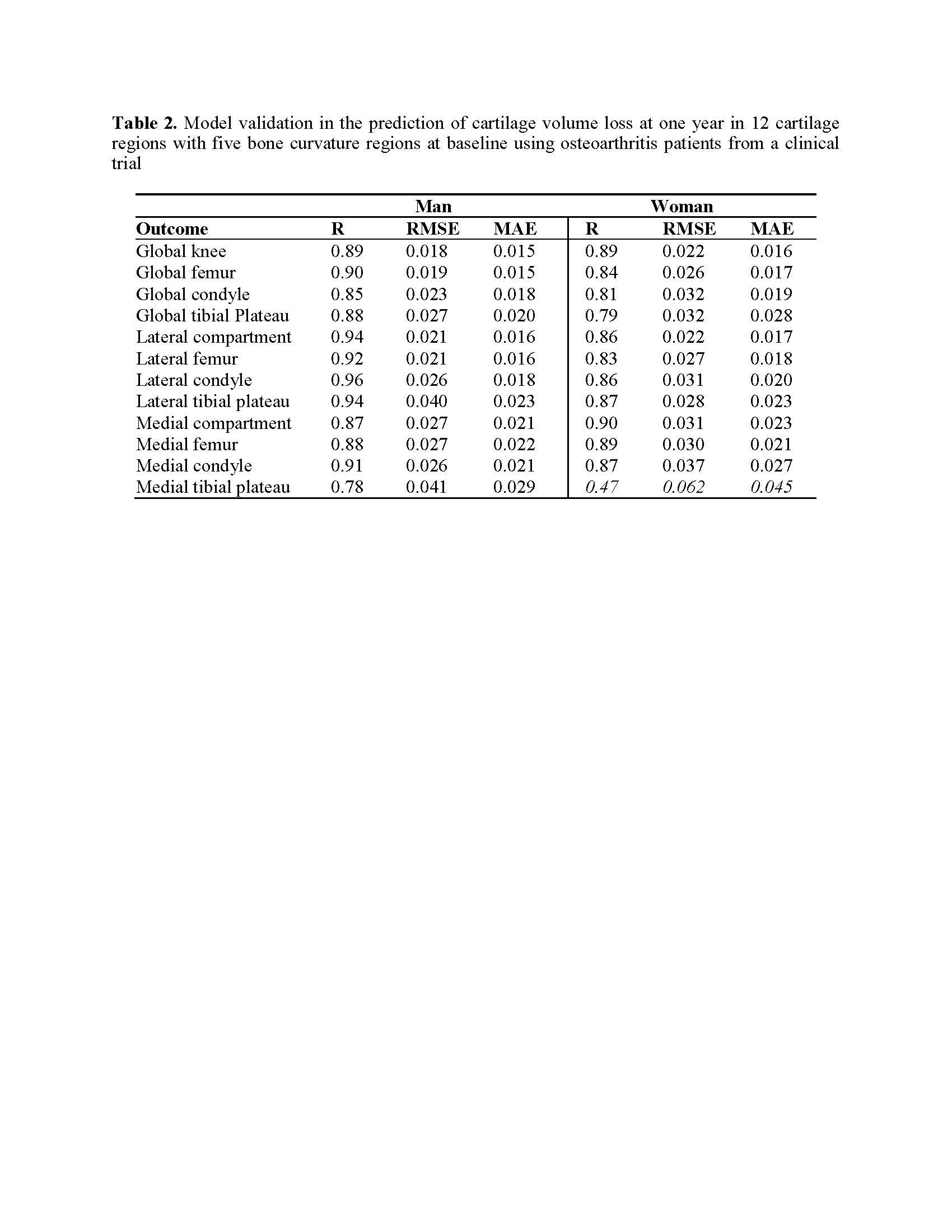Session Information
Session Type: Poster Session D
Session Time: 1:00PM-3:00PM
Background/Purpose: The hallmark of osteoarthritis is the loss of cartilage. At present, we cannot discriminate, early during the osteoarthritis process, patients for whom cartilage will degrade rapidly from those whose progression will be slow. By using machine learning (ML), we aimed to assess if baseline knee bone curvature could predict cartilage volume loss at one year and develop a gender-based ML model.
Methods: Participants (1246) from the Osteoarthritis Initiative cohort were classified as structural progressors using five baseline features from magnetic resonance imaging (MRI) and X-rays as described1. Bone curvature and cartilage volume assessments were performed using automated MRI systems as described2,3. Variables (inputs) included age, body mass index, and baseline values of eight bone curvature regions. The outcome (output) consisted of cartilage volume loss at one year in 12 global/regional regions. Five ML algorithms were assessed; ANFIS showed to be the most reliable for model development. Selection of the variable combination was performed using a systematic controllability variable reduction. Evaluation of the model performance uses three statistical indices: correlation coefficient (R), root mean square error (RMSE) and mean absolute error (MAE). Validation was done using osteoarthritis patients from a clinical trial.
Results: Data showed that knee cartilage volume loss at one year could be predicted in the 12 cartilage regions studied using five baseline bone curvature region values, including the lateral tibial plateau, medial central condyle, lateral posterior condyle, and lateral and medial trochlea, with very good accuracy for both genders: R ≥ 0.79 (Table 1). Validation demonstrated that generalization was attained in all studied cartilage regions for both genders (R ≥ 0.78), except in the medial tibial plateau for the woman (Table 2).
Conclusion: For the first time, we demonstrated a reliable and generalizable gender-based ML model to predict global and regional cartilage volume loss at one year based on five bone curvature regions at the baseline. This study offers a novel automated system for forecasting knee osteoarthritis cartilage degradation as a major step toward precision medicine. Such a model will significantly improve clinical prognosis with real-time patient monitoring.
To cite this abstract in AMA style:
Martel-Pelletier J, Bonakdari H, Pelletier J, Abram F. Baseline Bone Curvature a Biomarker for the Prediction of Knee Osteoarthritis Cartilage Volume Loss at One-Year. Use of Machine Learning [abstract]. Arthritis Rheumatol. 2022; 74 (suppl 9). https://acrabstracts.org/abstract/baseline-bone-curvature-a-biomarker-for-the-prediction-of-knee-osteoarthritis-cartilage-volume-loss-at-one-year-use-of-machine-learning/. Accessed .« Back to ACR Convergence 2022
ACR Meeting Abstracts - https://acrabstracts.org/abstract/baseline-bone-curvature-a-biomarker-for-the-prediction-of-knee-osteoarthritis-cartilage-volume-loss-at-one-year-use-of-machine-learning/


